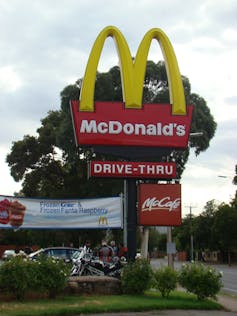OBESE NATION: It’s time to admit it - Australia is becoming an obese nation. This series looks at how this has happened and more importantly, what we can do to stop the obesity epidemic.
Here Suzie Ferrie explains why a fat tax isn’t enough to deal with the problem while Kathryn Backholer and Anna Peeters look at the relationship between socioeconomic status and weight.
We often hear calls for a junk food tax or “fat tax” when there’s discussion of Australia’s growing obesity problem. The idea behind such a tax is that it would enable governments to subsidise healthy foods so that they’re more affordable, and make unhealthy foods comparatively expensive so people buy less of them.
But would they really? Is cost really the most powerful determinant of what food products people buy?
Let’s consider the likely effects of a junk food tax. Researchers claim that a 20% tax on a can of soft drink would be a sufficient deterrent to purchasing it.
It’s easy to visualise this: someone approaches the refrigerator in a convenience store wanting to buy a drink and ready to make a decision based on taste and cost. If a soft drink is more expensive than low-fat milk or water, it becomes less attractive and we could see a change in buying behaviour – and the attendant reduction in the consumption of obesity-promoting products.

But the junk food tax idea falls over in other situations where food choices are made – when factors other than price come into play. Family dinner options, for instance, are rarely arrayed together in one location for a simple price comparison.
In lower-income areas, where obesity is disproportionately more common, main roads are lined with takeaway food outlets and the only greengrocer may not have a car park (let alone a drive-through service). Part of the attraction of takeaway food is that it provides instant satisfaction while demanding little in the way of (cooking) skills or (nutritional) knowledge.
Dinner options that require food preparation may be out of the question for people living in housing with inadequate cooking and food storage facilities. So, although I can prepare a vegetable and lentil curry with brown rice, followed by apple crumble with real egg custard, for a total of $3.39 per person, in disadvantaged communities this might not compare favourably with the “Five-dollar Meal Deals” offered by various takeaway chains, even if the meals were taxed until they became “Ten-dollar Meal Deals.”
And regardless of the price, it may be hard to sell my healthy $3.39 meal to someone accustomed to takeaway’s addictively sweet and salty and fatty flavours, low in vegetables and high in melt-in-the-mouth starches.

When people claim that healthy food is expensive, they are sometimes simply observing that processed foods labelled “diet” are priced higher, or that high-energy junk foods supply more (unneeded) calories per dollar than vegetables do. Both claims are true, but trivial.
But sometimes they are actually pointing out, correctly, that the real cost of my meal is more than $3.39 – that, unlike the takeaway alternative, this home-cooked dinner cost nearly an hour of my time. An hour that I might not be inclined to spare if I were tired and footsore from a hard low-income job and trying to feed fractious children as soon as possible.
And that my home-cooked meal required a number of different skills and resources I might take for granted, such as cooking ability and a functional kitchen. And that it would cost more than $50 if I had to fund the start-up cost of all the ingredients – the kilogram of flour and the bottle of oil, and so on – instead of just using (and costing) smaller amounts of items I already had.
My $3.39 meal is very nutritious. Unlike the takeaway meal, it provides the full spectrum of essential vitamins and minerals, as well as beneficial fibre and health-protective plant substances, at around 2800kJ per serve. Five-dollar meal deals, on the other hand, typically overfeed, with one meal providing 4300kJ or more (over half of a day’s requirement), as well as less protein and more fat than my version.
Better food labelling might help consumers realise this. But labelling also works best when your options are equally convenient and equally available, sitting side by side for comparison on the supermarket shelf or a food outlet’s menu. When this is not the case, labelling loses much of its power to influence food choices. Just as price manipulation strategies, such as a “fat tax”, do.

Efforts to combat obesity need to look beyond simple pricing strategies, to the underlying knowledge and skills that influence food choices. Just as physical activity is now compulsory at school, basic cooking (real basics, not just biscuits and pizza) should be an integral part of the personal development and life skills curriculum for all kids.
And rather than merely requiring a sink and food preparation area as they do now, building codes need to be updated so that adequate cooking facilities are mandatory in all dwellings. Communal kitchens are another suggestion worth considering.
An emphasis on improving skills means that rather than just punishing poor food choices, we equip people to make better ones - every day at home, not just in the convenience store.
This is part eight of our series Obese Nation. To read the other instalments, follow the links below:
Part one: Mapping Australia’s collective weight gain
Part two: Explainer: overweight, obese, BMI – what does it all mean?
Part three: Explainer: how does excess weight cause disease?
Part four: Recipe for disaster: creating a food supply to suit the appetite
Part five: What’s economic growth got to do with expanding waistlines?
Part six: Preventing weight gain: the dilemma of effective regulation
Part seven: Filling the regulatory gap in chronic disease prevention
Part nine: Education, wealth and the place you live can affect your weight
Part ten: Innovative strategies needed to address Indigenous obesity
Part eleven: Two books, one big issue: Why Calories Count and Weighing In
Part twelve: Putting health at the heart of sustainability policy
Part thirteen: Want to stop the obesity epidemic? Let’s get moving
Part fourteen: Fat of the land: how urban design can help curb obesity
Part fifteen: Industry-sponsored self-regulation: it’s just not cricket
Part sixteen: Regulation and legislation as tools in the battle against obesity

